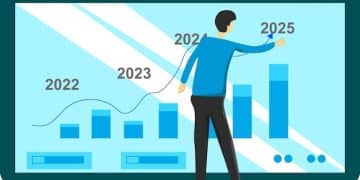Master 50/30/20 Budget: 2025 Income Allocation Guide

Achieving financial stability in 2025 requires strategic income management; the 50/30/20 budget method, earmarking 50% for needs, 30% for wants, and 20% for savings and debt, offers an effective, adaptable framework for optimal financial health.
In a world of evolving economic landscapes, managing your finances effectively is more crucial than ever. If you’re looking for a proven, adaptable strategy to take control of your money, keep reading as we explore how to start Mastering the 50/30/20 Budget: A 2025 Guide to Allocating Your Income Effectively. This approach could be the game-changer you need for financial peace of mind.
Understanding the 50/30/20 Rule: The Foundation for Financial Health
The 50/30/20 budget rule is a simple yet powerful framework designed to help individuals allocate their after-tax income effectively. Originating from Senator Elizabeth Warren and her daughter Amelia Warren Tyagi’s book, “All Your Worth: The Ultimate Lifetime Money Plan,” this method simplifies budgeting by dividing your income into three main categories: needs, wants, and savings/debt repayment. As we navigate 2025, economic shifts and technological advancements underscore the timeless relevance of this straightforward approach.
Its strength lies in its simplicity and adaptability, making it suitable for a wide range of financial situations. Unlike highly restrictive budgets that often lead to burnout, the 50/30/20 rule provides enough flexibility while still ensuring that significant progress is made towards financial goals. It encourages a balanced approach, preventing overspending in discretionary areas while prioritizing essential expenses and future security.
The Core Principles of Allocation
At its heart, the 50/30/20 rule is about mindful spending and strategic saving. It’s not about complex calculations or deprivation, but rather about creating a sustainable financial routine. Let’s delve into each percentage to fully grasp its meaning and how it applies to your 2025 financial plan.
- 50% for Needs: This category covers all essential expenses that are non-negotiable for living. Think of elements directly tied to your survival and basic functions.
- 30% for Wants: These are the expenses that enhance your lifestyle but aren’t strictly necessary. They bring enjoyment and comfort but could be cut if finances become tight.
- 20% for Savings & Debt Repayment: This crucial portion is dedicated to building your financial future and reducing liabilities. It’s the engine of long-term wealth accumulation and debt freedom.
By clearly defining and separating these categories, the 50/30/20 budget helps you identify where your money is truly going. This clarity is the first step towards gaining control over your finances and making informed decisions that align with your long-term objectives. It’s a proactive rather than reactive budgeting strategy.
Beyond its initial categorization, the rule also fosters a sense of financial discipline without imposing overly harsh restrictions. The idea is to create a spending plan that you can realistically stick to over time, leading to consistent progress rather than sporadic efforts. This consistency is vital for achieving significant financial milestones.
Deconstructing the 50%: Understanding Your Needs in 2025
The “needs” category forms the bedrock of the 50/30/20 budget. In 2025, defining what constitutes a “need” remains critical, though the specifics might evolve with inflation and lifestyle changes. Essentially, these are the costs you cannot realistically avoid and that are essential for maintaining your life and work.
This category includes your housing expenses, whether rent or mortgage payments, property taxes, and essential utilities like electricity, water, and heating. Food is another significant need, covering groceries for home-cooked meals. Transportation costs, necessary for getting to work or accessing essential services, also fall here, including car payments, insurance, fuel, or public transit passes. Health insurance and minimum loan payments (like student loans or credit card minimums) are also crucial needs to maintain your financial standing and well-being.
It’s important to differentiate needs from wants rigorously. For instance, a basic phone plan is a need for communication, but the latest premium smartphone model is a want. Groceries are a need, but dining out at high-end restaurants frequently is a want. This distinction is paramount to ensure your 50% allocation is genuinely covering essentials.
Essential Expenses: A Closer Look
Let’s break down the common elements typically found within the 50% for needs, considering the realities of 2025 living. Technology has become increasingly integrated into our daily lives, making some digital services borderline necessities. However, it’s crucial to evaluate each expense objectively.
- Housing: Rent/mortgage, property taxes, home insurance. These are often the largest portion of your needs.
- Utilities: Electricity, gas, water, internet (basic reliable service for work/life). Consider energy efficiency to manage these costs.
- Food: Groceries for home cooking. Focus on preparing meals at home to keep this within budget.
- Transportation: Car payments, fuel, insurance, public transport fares. Choose affordable options where possible.
- Healthcare: Insurance premiums, essential prescriptions. Don’t compromise on your health.
- Minimum Debt Payments: Student loans, credit card minimums. Avoiding defaults is a priority.
Carefully calculating these expenses is the first practical step in implementing the 50/30/20 rule. Review your bank statements, utility bills, and other financial records from the past few months to get an accurate average. This historical data provides a solid foundation for projecting your future needs without relying on guesswork. In 2025, subscription services have proliferated, making it easy to blur the lines between necessary and discretionary spending. Only essential subscriptions directly tied to basic functionality (e.g., a basic mobile plan for communication) should be classified as needs.
If your current essential expenses exceed 50% of your after-tax income, you’ll need to make adjustments. This could involve finding ways to reduce housing costs, cut back on transportation expenses, or re-evaluate your grocery budget. This initial assessment and potential restructuring are critical for the budget’s success.
Embracing the 30%: Allocating for Your Wants in 2025
The 30% allocation for “wants” is what makes the 50/30/20 budget sustainable and enjoyable. These are the expenses that improve your quality of life but aren’t essential for survival. This category acknowledges that financial discipline doesn’t mean living a life devoid of pleasure; it means consciously integrating those pleasures into a responsible financial plan. In 2025, understanding and managing these desires is especially important with the advent of new technologies and experiences.
Wants encompass a broad spectrum of discretionary spending. This could include dining out, entertainment subscriptions (streaming services, gaming), vacations, buying new gadgets, clothing beyond basic necessities, hobbies, gym memberships, and even that daily specialty coffee. The key is that if you could live without it, it’s a want.
This portion of your budget provides the flexibility often missing from more rigid budgeting systems. It allows room for personal enjoyment and treats, which can be crucial for long-term adherence to a financial plan. Without a dedicated “wants” category, people often feel deprived, leading to budget fatigue and eventual abandonment of financial goals.
Mindful Spending on Discretionary Items
Managing your 30% for wants requires mindfulness and intentionality. It’s not about guilt-free spending, but rather about guilt-aware spending. You have a set amount for these items; the goal is to make choices that maximize your satisfaction within that limit. Consider what truly brings you joy and prioritize those experiences.
- Entertainment: Streaming services, concerts, movies. Curate your subscriptions wisely.
- Dining Out & Beverages: Restaurants, cafes, bars. Limit frequency or choose more affordable options.
- Hobbies & Recreation: Sports, art supplies, club memberships. Focus on activities you genuinely enjoy.
- Shopping: New clothes, accessories, electronics, home decor. Distinguish between impulse buys and planned purchases.
- Travel: Vacations, weekend trips. Plan and save strategically for these experiences.
In 2025, the digital economy offers an endless array of “wants,” from virtual experiences to advanced consumer electronics. It’s easy for these expenses to quickly accumulate. Regularly review your subscriptions and discretionary purchases to ensure they align with your values and still fit within your 30% allocation. This periodic check-in helps prevent “subscription creep” or unconscious overspending.
If you find yourself consistently exceeding your 30% for wants, it’s a clear signal to re-evaluate. This might mean scaling back on certain activities, seeking more affordable alternatives, or even considering if some “wants” are inadvertently creeping into your “needs” category. The goal is to find a balance that feels both satisfying and financially responsible.
Securing Your Future: The 20% for Savings and Debt Repayment
The 20% allocation for savings and debt repayment is arguably the most critical component of the 50/30/20 budget for long-term financial security. This portion of your income is dedicated to building wealth, achieving financial freedom, and reducing your liabilities. It’s your investment in your future self and peace of mind.
This category typically includes contributions to an emergency fund, retirement accounts (401(k), IRA), investment accounts, and any extra payments towards high-interest debts like credit cards or personal loans beyond the minimum required. The emphasis here is on proactive financial growth and remediation.
In 2025, with economic uncertainties and evolving retirement landscapes, consistently contributing to these areas is more important than ever. This 20% isn’t just about saving money; it’s about creating financial resilience and opportunities. It’s what transforms your income into lasting wealth and security.
Strategic Savings and Debt Reduction
Optimal use of this 20% involves a strategic approach. It’s not just about setting money aside, but also about directing it to where it will have the most impact. Financial advisors often recommend prioritizing an emergency fund first, followed by high-interest debt, and then long-term investments.
- Emergency Fund: Aim for 3-6 months of essential living expenses in an easily accessible, high-yield savings account. This acts as a buffer against unexpected life events.
- High-Interest Debt: Prioritize paying down credit cards, personal loans, or other debts with high-interest rates. This reduces the total amount you pay over time.
- Retirement Savings: Contribute to your employer’s 401(k) (especially if there’s a company match), IRAs, or other retirement vehicles. The earlier you start, the more compound interest works in your favor.
- Investment Accounts: Beyond retirement, consider brokerage accounts for long-term investment goals like buying a house or funding education.

Automating your savings and debt payments is a highly effective strategy for adhering to this 20% rule. Set up automatic transfers from your checking account to your savings, investment, and debt accounts immediately after your paycheck hits. This “pay yourself first” approach ensures that these crucial allocations are made before you have a chance to spend the money elsewhere.
Periodically review your progress in this category. Are your emergency funds adequately stocked? Are you making headway on high-interest debt? Are your retirement contributions on track for your goals? Adjustments may be necessary as your income, expenses, and financial goals evolve throughout 2025.
Implementing the 50/30/20 Budget in 2025: A Step-by-Step Guide
Putting the 50/30/20 rule into practice doesn’t have to be daunting. With a clear roadmap and the right tools, you can successfully implement this budget and start seeing positive changes in your financial life in 2025. The process involves a few key steps, from calculating your income to tracking your spending.
The first and most crucial step is to understand your net income. This is your take-home pay after taxes, deductions for health insurance, and any other pre-tax contributions. This is the figure on which all your 50/30/20 allocations will be based. Without an accurate understanding of your net income, the percentages become meaningless. Be diligent in calculating this number, factoring in all sources of income, whether from a primary job, side hustle, or investments, to get a comprehensive view.
Your Implementation Checklist
Let’s outline the practical steps to get your 2025 budget up and running. Each step builds on the last, creating a robust and actionable plan.
- Calculate Your After-Tax Income: Gather all pay stubs and income statements to determine your total monthly net income. This is your starting point.
- Categorize Your Spending: For a month or two, meticulously track all your expenses. Label each transaction as a “need,” “want,” or “saving/debt repayment.” This initial data collection is crucial for understanding your current habits.
- Adjust and Reallocate: Compare your actual spending against the 50/30/20 percentages. Identify areas where you are overspending or underspending and make conscious decisions to adjust.
- Automate Your Finances: Set up automatic transfers for savings and debt payments immediately after payday. This ensures consistency and reduces the temptation to spend.
- Regular Review and Adjustment: Life changes, and so should your budget. Review your finances monthly or quarterly to ensure your allocations still make sense and adjust as needed.
Utilizing budgeting apps or spreadsheets can significantly simplify the categorization and tracking process. Many digital tools available in 2025 offer detailed insights into spending patterns, making it easier to identify areas for adjustment. The initial phase of tracking might feel tedious, but it provides invaluable data about your financial behavior, which is essential for making informed budgeting decisions.
Don’t be discouraged if your initial numbers don’t perfectly align with the 50/30/20 rule. The goal is progress, not perfection. It might take a few months to fine-tune your spending habits and allocations to fit the framework. Be patient and persistent, focusing on incremental improvements rather than an overnight transformation. The key is to commit to the process.
Overcoming Common Challenges and Adapting for 2025
While the 50/30/20 budget is straightforward, implementing it can present challenges, especially with the unique economic factors of 2025. Rising inflation, unpredictable job markets, and unexpected expenses can all test your financial discipline. However, the adaptability of this budget method allows for adjustments to navigate these hurdles effectively.
One common challenge is when your “needs” exceed 50% of your income, particularly in high-cost-of-living areas. In such cases, a strict adherence to the percentages might be unrealistic initially. The solution isn’t to abandon the budget but to adapt it. This might involve temporarily shifting more towards needs and less towards wants or savings, with a clear plan to rebalance as circumstances improve.

Another hurdle is maintaining discipline, especially with the allure of consumerism. Distinguishing between a “want” and a “need” can sometimes be difficult, and impulse purchases can quickly derail your “wants” budget. Regular self-assessment and accountability partners can be beneficial here.
Tactics for Budgeting Success in the Modern Era
To ensure your 50/30/20 budget thrives in 2025, consider these proactive strategies. These tactics are designed to address common pitfalls and leverage modern resources to your advantage.
- Optimize Your Needs: Can you refinance your mortgage, find a cheaper insurance provider, or reduce utility consumption? Even small cuts in your 50% free up significant funds.
- Smart Wants Management: Implement a “waiting period” for non-essential purchases. Automate small splurges into your “wants” budget so they don’t impact other categories.
- Boost Your Income (if possible): Consider a side hustle or negotiate a raise. Even a small increase can make it easier to hit your 20% savings goal.
- Leverage Technology: Use budgeting apps with sophisticated categorization and tracking features. Many apps now incorporate AI for personalized financial insights.
- Review Regularly: Life isn’t static. Revisit your budget every month or quarter and adjust percentages or categories as your life situation changes (e.g., new job, family changes).
Unexpected expenses, like car repairs or medical bills, are inevitable. This is precisely why the 20% allocated for savings (particularly an emergency fund) is crucial. Having that buffer prevents these unforeseen costs from derailing your entire budget and forcing you into debt. If an emergency fund isn’t fully established, consider funneling a larger portion of your 20% into it initially.
Adapting the 50/30/20 rule to your specific circumstances is key to its success. It’s a guideline, not a rigid law. If your income is lower or your cost of living extremely high, you might start with a 60/20/20 or even 70/20/10 split, gradually working towards the ideal 50/30/20 as your situation improves. The underlying principle of conscious allocation remains the guiding force.
Advanced Strategies: Maximizing Your 50/30/20 Budget
Once you’ve mastered the basics of the 50/30/20 budget, you can explore advanced strategies to further optimize your financial plan. This isn’t about radically changing the percentages but enhancing their effectiveness through smart financial moves and long-term thinking. In 2025, maximizing every dollar counts.
One powerful strategy is to “reverse budget,” meaning you allocate your 20% to savings and debt repayment first, immediately upon receiving your paycheck. This ensures your financial future is prioritized before any other spending occurs. This psychological shift can significantly boost your savings rate and accelerate debt repayment, as you consciously spend from what remains.
Smart Moves for Enhanced Financial Growth
Here are some advanced tactics to stretch your 50/30/20 budget further and accelerate your financial goals, particularly relevant for the economic landscape of 2025.
- “Snowball” or “Avalanche” Debt Repayment: For your 20% debt repayment, strategically attack high-interest debts (avalanche method) or focus on smallest debts for psychological wins (snowball method).
- Income Optimization: Explore tax-advantaged accounts like HSAs (Health Savings Accounts) or FSAs (Flexible Spending Accounts) to reduce your taxable income, effectively giving you more net income to allocate.
- Investment Diversification: Beyond basic retirement accounts, consider diversifying your investments within your 20% to include a mix of stocks, bonds, and potentially real estate or alternative assets, aligned with your risk tolerance.
- “Found Money” Management: Allocate any unexpected windfalls—bonuses, tax refunds, gifts—strategically. Consider directing a significant portion to your 20% category for accelerated savings or debt reduction.
- Financial Education: Continuously educate yourself about personal finance. Understanding market trends, investment vehicles, and tax laws can help you make more informed decisions within your budget framework.
Another advanced technique involves periodically reviewing and re-negotiating your recurring “needs” and “wants” expenses. For instance, call your insurance providers annually to check for better rates, or evaluate your internet and phone plans to ensure you’re not overpaying. Even small, consistent savings in your 50% or 30% categories can free up a substantial amount to be redirected to your 20%, significantly impacting your long-term wealth building.
Consider the potential for “geo-arbitrage” if your job allows. Moving to a lower cost of living area could drastically reduce your 50% “needs,” freeing up a larger portion of your income for other categories. While a significant lifestyle change, it’s an advanced strategy for those seeking drastic financial acceleration. These advanced methods require consistent effort and a deeper understanding of financial principles, but the rewards in financial security and freedom are substantial.
| Key Aspect | Brief Description |
|---|---|
| 🏠 50% Needs | Essential expenses like housing, utilities, food, and basic transportation. Non-negotiable costs for living. |
| 🛍️ 30% Wants | Discretionary spending that enhances lifestyle but isn’t strictly necessary, like dining out or entertainment. |
| 💸 20% Savings & Debt | Allocated for building wealth, emergency funds, investments, and paying down high-interest debt. |
| 🔄 Adaptability | The rule is flexible; adjust percentages based on income, location, and economic changes (e.g., higher needs in HCOL areas). |
Frequently Asked Questions About the 50/30/20 Budget
After-tax income refers to your net pay, the amount of money you actually receive after all mandatory deductions like federal and state taxes, Social Security, Medicare, and any pre-tax contributions such as health insurance premiums or 401(k) contributions are subtracted from your gross income. This is the figure you use to calculate your 50/30/20 percentages.
If your needs exceed 50%, it’s a common challenge. You might need to temporarily adjust by decreasing your “wants” or “savings” percentages, perhaps aiming for a 60/20/20 split. Focus on finding ways to reduce your essential expenses, like negotiating bills or living more frugally, to gradually work towards the ideal 50% for needs.
It’s advisable to review your budget at least monthly, and ideally quarterly. This allows you to track your spending, assess if your allocations are still accurate, and make adjustments as your income, expenses, or financial goals change. Regular reviews ensure your budget remains a relevant and effective tool for financial management.
Generally, it’s recommended to build a small emergency fund (e.g., $1,000-$2,000) first. Then, prioritize high-interest debt repayment, as the interest saved can be substantial. Simultaneously, contribute at least enough to your 401(k) to get any employer match, as it’s free money. After high-interest debt and employer match, focus on building a full emergency fund (3-6 months’ expenses) and optimizing other investments.
The 50/30/20 rule is highly adaptable, but its direct application can be more challenging for very low-income individuals where 50% of income might not even cover basic needs. In such cases, the percentages might need to be adjusted, focusing heavily on reducing needs first. For higher incomes, it might be easier to exceed the 20% savings goal, accelerating wealth building.
Conclusion
Mastering the 50/30/20 Budget: A 2025 Guide to Allocating Your Income Effectively offers a robust and adaptable framework for achieving financial well-being. By clearly categorizing your expenses into needs, wants, and savings/debt repayment, you gain invaluable clarity and control over your money. This method empowers individuals to make conscious financial decisions, fostering discipline without sacrificing all enjoyment. As economic landscapes evolve, the principles of balancing essential spending with discretionary desires and future planning remain timeless. Embracing this budget is not just about numbers; it’s about building a sustainable financial future, fostering peace of mind, and empowering yourself to navigate 2025 and beyond with confidence and stability.





